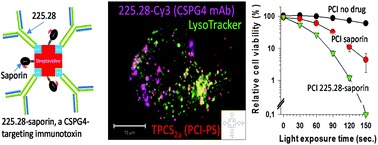当前位置:
X-MOL 学术
›
Photochem. Photobiol. Sci.
›
论文详情
Our official English website, www.x-mol.net, welcomes your
feedback! (Note: you will need to create a separate account there.)
Enhanced targeting of triple-negative breast carcinoma and malignant melanoma by photochemical internalization of CSPG4-targeting immunotoxins†
Photochemical & Photobiological Sciences ( IF 2.7 ) Pub Date : 2018-03-06 00:00:00 , DOI: 10.1039/c7pp00358g M S Eng 1 , J Kaur 1 , L Prasmickaite 2 , B Ø Engesæter 2 , A Weyergang 1 , E Skarpen 3 , K Berg 1 , M G Rosenblum 4 , G M Mælandsmo 2 , A Høgset 5 , S Ferrone 6 , P K Selbo 1
Photochemical & Photobiological Sciences ( IF 2.7 ) Pub Date : 2018-03-06 00:00:00 , DOI: 10.1039/c7pp00358g M S Eng 1 , J Kaur 1 , L Prasmickaite 2 , B Ø Engesæter 2 , A Weyergang 1 , E Skarpen 3 , K Berg 1 , M G Rosenblum 4 , G M Mælandsmo 2 , A Høgset 5 , S Ferrone 6 , P K Selbo 1
Affiliation

|
Triple-negative breast cancer (TNBC) and malignant melanoma are highly aggressive cancers that widely express the cell surface chondroitin sulfate proteoglycan 4 (CSPG4/NG2). CSPG4 plays an important role in tumor cell growth and survival and promotes chemo- and radiotherapy resistance, suggesting that CSPG4 is an attractive target in cancer therapy. In the present work, we applied the drug delivery technology photochemical internalization (PCI) in combination with the novel CSPG4-targeting immunotoxin 225.28-saporin as an efficient and specific strategy to kill aggressive TNBC and amelanotic melanoma cells. Light-activation of the clinically relevant photosensitizer TPCS2a (fimaporfin) and 225.28-saporin was found to act in a synergistic manner, and was superior to both PCI of saporin and PCI-no-drug (TPCS2a + light only) in three TNBC cell lines (MDA-MB-231, MDA-MB-435 and SUM149) and two BRAFV600E mutated malignant melanoma cell lines (Melmet 1 and Melmet 5). The cytotoxic effect was highly dependent on the light dose and expression of CSPG4 since no enhanced cytotoxicity of PCI of 225.28-saporin compared to PCI of saporin was observed in the CSPG4-negative MCF-7 cells. The PCI of a smaller, and clinically relevant CSPG4-targeting toxin (scFvMEL-rGel) validated the CSPG4-targeting concept in vitro and induced a strong inhibition of tumor growth in the amelanotic melanoma xenograft A-375 model. In conclusion, the combination of the drug delivery technology PCI and CSPG4-targeting immunotoxins is an efficient, specific and light-controlled strategy for the elimination of aggressive cells of TNBC and malignant melanoma origin. This study lays the foundation for further preclinical evaluation of PCI in combination with CSPG4-targeting.
中文翻译:

通过 CSPG4 靶向免疫毒素的光化学内化增强三阴性乳腺癌和恶性黑色素瘤的靶向性†
三阴性乳腺癌 (TNBC) 和恶性黑色素瘤是高度侵袭性的癌症,广泛表达细胞表面硫酸软骨素蛋白聚糖 4 (CSPG4/NG2)。CSPG4在肿瘤细胞生长和存活中起重要作用,并促进化疗和放疗耐药,表明CSPG4是癌症治疗中一个有吸引力的靶点。在目前的工作中,我们将药物递送技术光化学内化 (PCI) 与新型靶向 CSPG4 的免疫毒素 225.28-皂草素相结合,作为杀死侵袭性 TNBC 和无色素黑色素瘤细胞的有效和特异性策略。发现临床相关光敏剂 TPCS 2a(非马泊芬)和 225.28-皂草素的光激活以协同方式起作用,并且优于皂草素的 PCI 和 PCI-no-drug (TPCS在三种 TNBC 细胞系(MDA-MB-231、MDA-MB-435 和 SUM149)和两种 BRAFV600E 突变的恶性黑色素瘤细胞系(Melmet 1 和 Melmet 5)中的2a + 光)。细胞毒性作用高度依赖于光剂量和 CSPG4 的表达,因为在 CSPG4 阴性 MCF-7 细胞中未观察到 225.28-皂素 PCI 的细胞毒性与皂素 PCI 相比没有增强。较小且临床相关的 CSPG4 靶向毒素 (scFvMEL-rGel) 的 PCI在体外验证了 CSPG4 靶向概念并在无色素黑色素瘤异种移植 A-375 模型中诱导强烈抑制肿瘤生长。总之,药物输送技术 PCI 和靶向 CSPG4 的免疫毒素的结合是一种有效、特异性和光控的策略,用于消除 TNBC 和恶性黑色素瘤来源的侵袭性细胞。本研究为 PCI 结合 CSPG4 靶向的进一步临床前评估奠定了基础。
更新日期:2018-03-06
中文翻译:

通过 CSPG4 靶向免疫毒素的光化学内化增强三阴性乳腺癌和恶性黑色素瘤的靶向性†
三阴性乳腺癌 (TNBC) 和恶性黑色素瘤是高度侵袭性的癌症,广泛表达细胞表面硫酸软骨素蛋白聚糖 4 (CSPG4/NG2)。CSPG4在肿瘤细胞生长和存活中起重要作用,并促进化疗和放疗耐药,表明CSPG4是癌症治疗中一个有吸引力的靶点。在目前的工作中,我们将药物递送技术光化学内化 (PCI) 与新型靶向 CSPG4 的免疫毒素 225.28-皂草素相结合,作为杀死侵袭性 TNBC 和无色素黑色素瘤细胞的有效和特异性策略。发现临床相关光敏剂 TPCS 2a(非马泊芬)和 225.28-皂草素的光激活以协同方式起作用,并且优于皂草素的 PCI 和 PCI-no-drug (TPCS在三种 TNBC 细胞系(MDA-MB-231、MDA-MB-435 和 SUM149)和两种 BRAFV600E 突变的恶性黑色素瘤细胞系(Melmet 1 和 Melmet 5)中的2a + 光)。细胞毒性作用高度依赖于光剂量和 CSPG4 的表达,因为在 CSPG4 阴性 MCF-7 细胞中未观察到 225.28-皂素 PCI 的细胞毒性与皂素 PCI 相比没有增强。较小且临床相关的 CSPG4 靶向毒素 (scFvMEL-rGel) 的 PCI在体外验证了 CSPG4 靶向概念并在无色素黑色素瘤异种移植 A-375 模型中诱导强烈抑制肿瘤生长。总之,药物输送技术 PCI 和靶向 CSPG4 的免疫毒素的结合是一种有效、特异性和光控的策略,用于消除 TNBC 和恶性黑色素瘤来源的侵袭性细胞。本研究为 PCI 结合 CSPG4 靶向的进一步临床前评估奠定了基础。











































 京公网安备 11010802027423号
京公网安备 11010802027423号